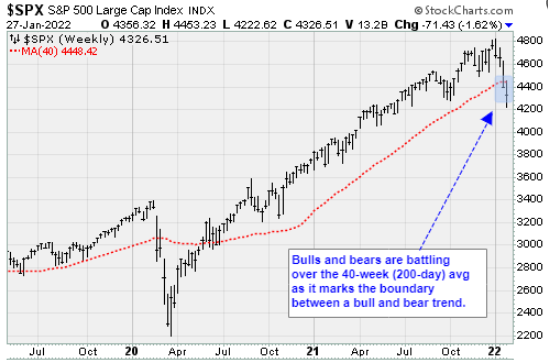Bulls ran headlong on Thursday morning into key resistance for the S&P 500 (SPX) at 4,430, suggests Jon Markman, editor of Strategic Advantage.
For the second time in as many days, they were beaten back. An early 1.3% gain was erased by late afternoon. The benchmark S&P 500 (SPX) finished at 4,326, down 0.6%.
Sometimes, understanding the stock market is really simple. It is about bulls and bears fighting over a key level, in this case the 200-day moving average for the benchmark at 4,430. Bull markets live above that marker. Bear markets thrive below.

After the close on Thursday, consumer electronics giant Apple (AAPL) posted solid quarterly financial results and shares zoomed higher. All things being equal, this should help bulls make another run at 4,430. If they are beaten back again, I expect a test of critical support back at 4,210—Monday’s reaction low for the S&P 500.
The bottom line is that bulls have a window of opportunity—but it is closing quickly.
Details
The Nasdaq (IXIC) slid 1.4% to 13,352.78 after surrendering early gains. The Dow (DJI) ended fractionally lower at 34,160.78.
The energy and utilities sectors fared best while consumer discretionary and real estate stocks lagged. The 10-year US Treasury yield fell four basis points to 1.80%. Breadth favored decliners three-one, and there were 1,112 new lows vs 74 new highs, a very oversold condition. Big caps on the new high list included Exxon (XOM), Chevron (CVX), Royal Dutch Shell (RDS-A), HSBC Holdings (HSBC), and CVS Health Corporation (CVS). Oil drillers and drug stores are your leaders…yeech…not exactly a bull market vanguard.
A new report showed the US gross domestic product grew at a 6.9% annualized rate in the fourth quarter, above the 5.5% growth estimated in a Bloomberg survey. The GDP expanded at a 2.3% annualized rate in the third quarter. That’s awesome, but it is coming off a hard low, to be fair. Wednesday's Federal Open Market Committee statement confirmed Fed policy will soon tighten, with a rate lift-off likely at the next meeting in March.
Federal Reserve Chair Jerome Powell wouldn't commit when asked how quickly that tightening would proceed, with a much faster pace than previously anticipated by markets not ruled out. Powell repeatedly emphasized that economic conditions are now significantly different from those prevailing before the Covid-19 pandemic, with inflation running hot, growth strong, and the labor market likely to be highly resilient to several rate hikes.
West Texas Intermediate crude oil slipped 0.3% to $87.11 per barrel, a fresh seven-year high, as the threat of a Russian invasion of Ukraine continued to raise supply security concerns.
The US dollar continued to rise. The dollar index, a gauge of the greenback's strength against a basket of currencies, jumped 1.4% to an 18-month high.
The rise came as Russia, the world's number two oil producer, continued to mass troops on its border with Ukraine, while NATO placed its troops in Europe on alert. The US and NATO both offered written responses to Russian demands Wednesday that Russia said did not offer "much cause for optimism," according to the New York Times. Russia is expected to face immediate sanctions from the US and its allies should it attack Ukraine. While it is unclear if Russia's crude oil exports of five million barrels per day or natural gas shipments would be affected, the market is pricing in a risk premium in case supplies are cut, Commerzbank analyst Carsten Fritsch said in a note.
In other economics news, personal consumption rose 3.3% in the fourth quarter, faster than the 2% increase in the third quarter. Goods spending posted a small increase after a decline in the third quarter, while services spending growth slowed for a second straight quarter, though it was still brisk.
Inflation accelerated in the fourth quarter. The personal consumption expenditures price index rose at a 6.5% annualized rate and the core PCE price index grew 4.9% annualized, both ahead of their third-quarter rates. Initial jobless claims decreased by 30,000 to 260,000 in the week ended January 22, though the four-week moving average rose by 15,000 to 247,000 for a fourth consecutive gain.
Subscribe to Jon Markman's Strategic Advantage here…




















